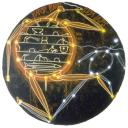A new article by Vogt and Magnussen (PubMed ID:17357707) was discussed at the site Cognitive Daily (note to self: add to Bloglines account). The article describes research to examine what artists and non-artists focus on while looking at an image. They found that psychologists (or, non artists, as they are called in the article) tend to focus on identifiable components of an image while trained artists do not necessarily focus their eyes on the objects in an image.
This article is a nice attempt to get at how artists see, and by this, get at how artists think. The images in the article (found at Cognitive Daily) clearly describe the eye paths by the artists and non-artists.
Some reactions to this article:
- what kind of artists were used in this study? would a photographer, who deals with making images on a flat, single plane, respond visually in the same way as a printmaker, who deals with making images in layers?
- perhaps when artists first look at an image they take it all in at once, and then spend time roaming their eyes over the image to “feel” about the image. maybe artists are concerned less with the content of an image and more about the concept. this idea is supported by the eye paths noted in the article, where the path seems to be non-specific, non-focused on any particular component of the image.
- i was not surprised to learn that both non-artists and artists focus more on identifiable components of an image when directed to “remember” what was in the image. this is a task-based directive, engaging a different part of the brain. it was nice to see how this works in the eye path pictures.



